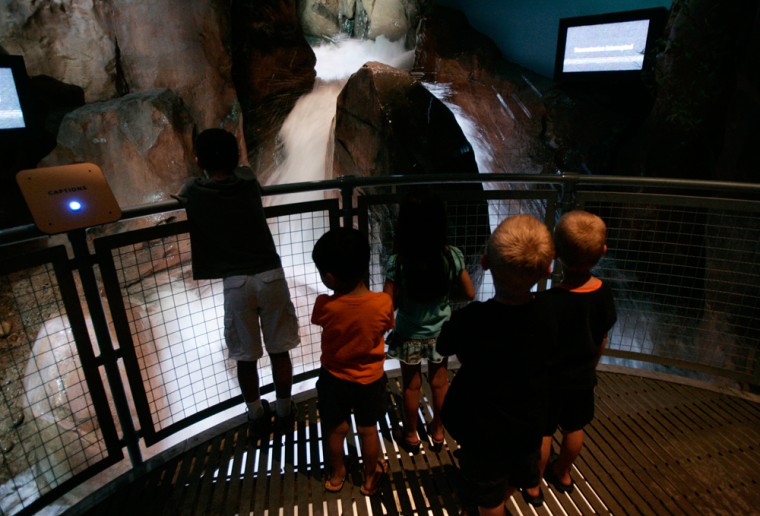It's been 178 years since a New Mexican merchant found a spring surrounded by scarce greenery in the parched Mojave Desert and called it the Spanish word for "the meadows."
Now the water source that gave Las Vegas its name and slaked the thirsts of travelers on the Old Spanish Trail is getting new life in a typically Las Vegas way: reimagined and recreated, bigger and better.
The Las Vegas Springs Preserve, which is designed to show Las Vegas' past and provide a glimpse at a sustainable future, opened in June at a cost of $250 million reaped from the sale of federal land around southern Nevada.
It's close enough to see the stunning skyline of the lavish resorts featuring dancing fountains on the Strip, but a world away when meandering from trail to gallery to garden. Everything is wheelchair-accessible.
"Ideally, this represents to Las Vegas what Central Park represents to New York City," preserve spokesman Jesse Davis said, expressing a theme as carefully crafted as the faux rock canyons and the centerpiece five-building Desert Living Center.
Water doesn't trickle here naturally any more. That's lesson one at the Springs Preserve.
But it gushes like a flash flood through "Mojave Canyon" at the OriGen Experience, an interactive exhibit hall sure to excite the kids while teaching about the desert, its dwellers, its dangers and its future. Designers call it a "playducational" museum.
"It felt like it was real," exclaimed 10-year-old Jules Jaget, a Las Vegas fifth-grader who said she was surprised when 5,000 gallons of recycled water whooshed down a recreated desert ravine in front of her and rushed beneath the walkway at her feet.
Water — whether too much or too little — is the elemental theme of the 180-acre preserve, three miles west of downtown.
"It's a cultural focal point, a historic centerpiece," Davis said, "something that offers something for everyone."
A hot summer day found moms with their children and their children's' playmates disappearing into exhibit nooks, playgrounds and the gift shop.
"This is great to do with kids on vacation," said Cristi Milad, 38, a mother chaperoning four children, including Jaget, who said she also liked learning about furry, feathered and scaly desert critters, and the night-vision exhibit showing owls hunting lizards by moonlight beneath creosote bushes.
"We can occupy them for many hours, it's educational, and there's air conditioning inside when you need to be out of the sun," Milad said.
No neon or gambling here — although there are echoes of slot machines in the wow-your-teen interactive arcade, and a card-dealing video rewards correct answers to questions about Las Vegas with virtual stacks of poker-style chips.
Fact: "The average annual rainfall in Las Vegas is 4.49 inches." So says the writing on the wall between a Pacman style "Lawn Gobbler" video game that devours grassy turf toward a goal of helping to keep Lake Mead full.
A theater shows how the reservoir was formed with the construction of the colossal Hoover Dam on the Colorado River: 1935, a crucial date for a region that now gets almost all its drinking water from the nearby lake.
Visitors get to see how Pueblo Indians lived here for eons before merchant and explorer Antonio Armijo arrived in 1829; and how the San Pedro, Los Angeles and Salt Lake Railroad followed, put in a water stop, and held a large land auction in 1905.
Everything seems hands-on, except the cactus. There are buttons to activate exhibit stories, a lever to show how a steam engine builds power, faucets to turn to reveal correct answers to recycling questions, touch-screens, joysticks, fossil scanners and a chance to try to fit broken pieces of Indian pottery together.
Children duck into little caves to see all manner of snakes, birds, lizards, tortoises, gila monsters, and a gray fox the size of a large house cat sleeping in his air conditioned lair by day so he can venture into his outdoor enclosure at night.
Over the years, more than 250 wildlife species have been documented at the springs. But the site was neglected for decades — with little but industrial-looking water works and a couple of weathered wooden derricks left to mark the spot designated as a national historic site in 1978.
The Las Vegas Valley Water District, which owns the land, established a nonprofit to raise funds, reshape and operate the preserve.
Critics decry the Strip-level ticket prices — $18.95 for adult out-of-towners, with kids under 4 free.
But entry is free to the eight acres of demonstration gardens and 1.25 miles of trails now open and winding through an area dubbed the cienega — Spanish for a desert wetland, with native plants, bird and animals.
Davis tallied more than 30,000 paying customers in the six weeks after the preserve debuted in June with a concert by pop singer-songwriter Jewel in a 2,000-seat artificial turf amphitheater.
Another lesson. Turf conserves water; grass guzzles it.
Solar panels shade cars in the parking area and generate enough electricity to power 70 percent of the preserve. The water system is designed to be self-sustaining — flowing through exhibits, buildings and restrooms, collecting "gray water" for treatment, then irrigating native desert and drought-tolerant trees and flowers.
Preserve designers applied for platinum Leadership in Energy and Environmental Design certification from the U.S. Green Building Council after using recycled and reused materials to build buildings demonstrating energy efficiency and resource sustainability.
The lesson, echoed with a banner in a Desert Living Center pavilion: "Nothing Disappears."
